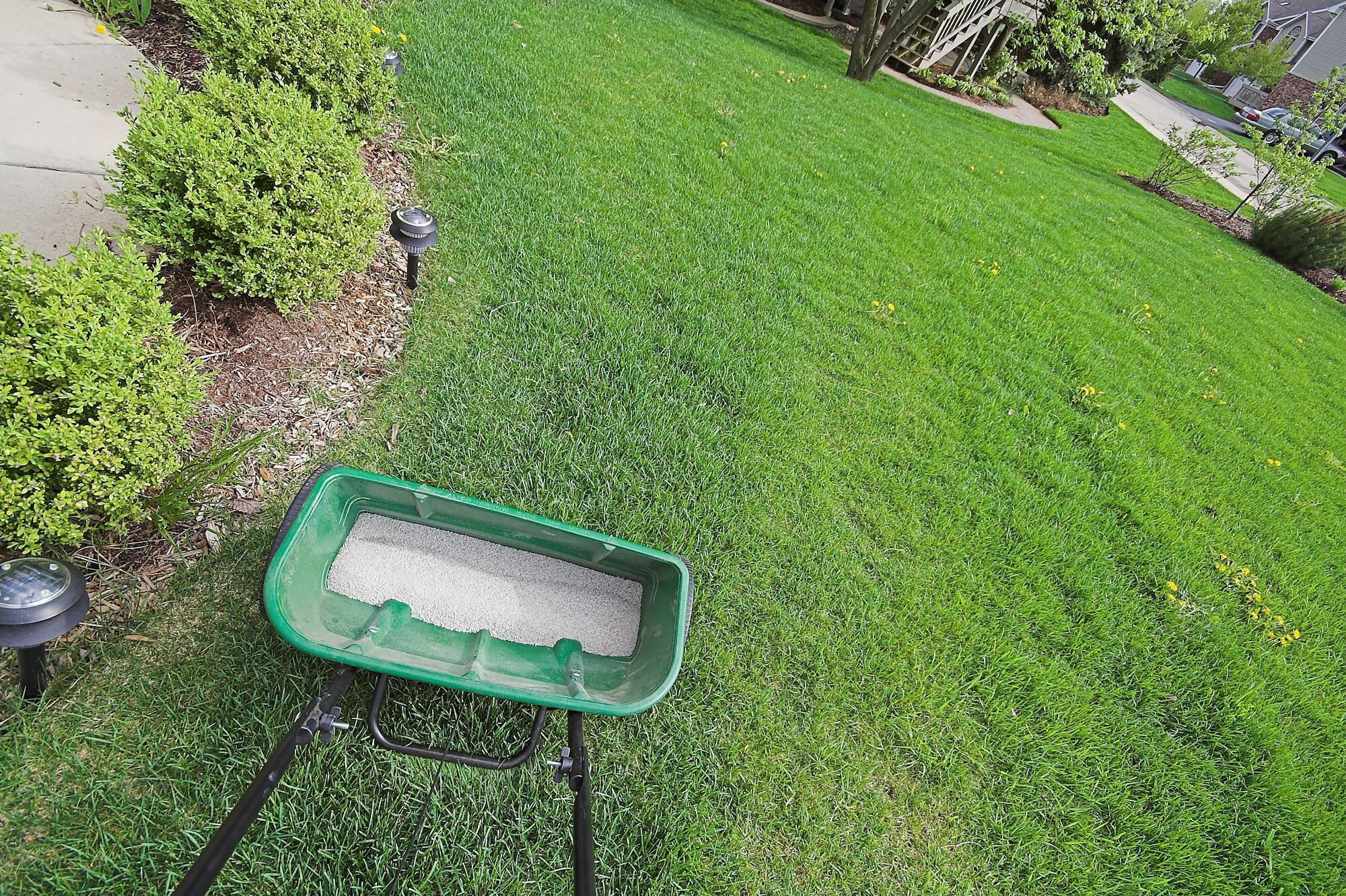Your Total Summer Lawn Care Guide
The summer months are a time to enjoy everything that a lush and green lawn has to offer—family barbecues, long afternoons to unwind, and simply a beautiful sight to spot from your window. If you’re hoping to maintain a lawn that is the envy of the neighborhood, prepare for the hot months ahead with confidence.
The warmest time of year can bring about a string of issues with your turf. Grubs and insects are more likely to flourish, moisture is trickier to balance, and patches of yellow and brown grass can pop up without notice.
If you understand what’s going on in your lawn’s ecosystem over the summer, however, it is much easier to control your grass’s health. In this guide, we’ll cover all you need to know about how to tailor your summer lawn care regimen to your unique property.

Warm vs. Cool Season Grasses
Before we dive into the month-by-month summer guide, it’s important to note whether you have warm or cool-season grasses. In most cases, you can figure this out simply by where you live.
The southern coastal states typically have one type of grass per lawn—more specifically, a warm-season grass. This means that the variety of grass flourishes in hotter temperatures during the summer. Their primary growth period occurs in temperatures as high as 95 degrees, and as expected, typically cannot handle the winter weather found in the north.
The majority of the northern US is considered in the cool-season grass zone, where the grass grows best in between 50 and 80 degrees Fahrenheit. These grasses fare better in the winter and go into a dormancy period that keeps them safe from the frost. Their summer care will differ from the warm grasses in the south.
In between these two stages, the transitional growing zone of the country typically includes a mixture of both warm and cool-season grasses in lawns. Speak with your local TruGreen team to determine the best products and schedule for your type of grass.
Early Lawn Care Tips
As you transition from spring to summer, there may be some spring lawn care tasks that had to wait for these later months. In some cases, it simply wasn’t warm enough to reseed until June, or perhaps there was too much rain and therefore never appropriate to aerate.
Here are some June lawn care tips to kick off your summer right.
1. Fine Tune Your Mowing Habits
No matter the type of grass you have, summer is the time to let it grow free. If you haven’t done so already in the spring, raise your mower blades to only take about an inch off the top of your blades.
Summer grass should typically be allowed to grow between two and three inches, so wait until it’s reached an inch above this to mow. By only removing the top third when necessary, you give the grass a chance to root deep into the earth.
Strong grass with thick roots is healthier, protects against weeds, and discourages erosion. Additionally, we always recommend leaving your grass clipping on your lawn to decompose. This allows the organic material to return to the soil.
2. Fertilize
This is when it is particularly important to know if you have a warm-season grass in your lawn. Warm-season grasses should be fertilized in the summer since they are at their peak season of growth. If you have cool-season grasses or a mixture of the two, fertilize in the spring instead.
Choose a slow-release fertilizer unless you have a lot of damage on your lawn and recent reseeded. Slow-release options will fill your lawn with a balance of potassium, phosphorus, and nitrogen over time throughout the warm season.
This extra boost of nutrients will help your lawn fight off drought and sun damage in extreme heat.
3. Check for Grubs
For the first time in the season, keep a lookout for the pesky larvae of Japanese Beetles—known as grubs. Grubs enjoy nibbling on the roots of your grass, causing dead spots throughout your lawn when left unchecked.
While there’s nothing wrong with a few grubs on your lawn, finding more than nine per square foot is commonly a sign of a problem. You may know that you have grubs in your lawn this early in the season if you have small rodents and animals digging in your lawn. Grubs can also cause your grass to feel particularly sponge-like when walked on.
If you do find that you have more grubs than you’d like, spread a grub treatment in these early months. You can also encourage natural grub predators like birds into your lawn.
Midsummer Lawn Care
As the summer heads toward its peak, it’s important to adjust your watering and mowing schedule depending on the weather that comes your way. Hot and humid weather can also lead to pesky issues like fungus and pest infestations. Here are some ways to keep your lawn healthy in July, especially if you plan to head out of town for vacation.
1. Focus on Weeds
When sun and rain are at their peak, it may feel impossible to get ahead of weeds, especially if your pre-emergent treatment didn’t work in the spring. At this point in the season, opt for a targeted approach to weed removal, either with a post-emergent liquid or removing them by hand by the root.
Be cautious, however. Post-emergent weed treatment, even natural varieties, can harm the grass around your weeds, leading to larger issues. In the long term, the best way to cut out weeds for good is to maintain a strong and healthy lawn. The stronger the grass, the less space weeds will have to thrive.
2. Get Into a Watering Schedule
The summer months may be hot, but the name of the game at this time of year is to water less frequently and deeper into the soil. By drenching your lawn once a week, it is easier to avoid the issues that come along with too much moisture—such as pests and fungus.
Drench your lawn so that the water reaches at least 5 inches into the ground. Your grass should bounce back with energy after walking on it, otherwise it may be too dry.
The time of day is also crucial when finding the best time to water your lawn in the summer. Stick to early in the morning before work or just after sunrise, or in the late afternoon when there are still several hours of indirect light.
If you water at the peak of the day’s heat, the water may evaporate too quickly to make it into the soil. Too late in the day, however, means that the water will not dry quickly enough, leaving it to sit on your grass and cause moisture complications.
3. Look Out for Pests
July is the peak season for many pesky insects around the country, especially biting and stinging insects that have set up nests around your home. If mosquitoes are plaguing your area, check to see if puddles of water are pooling after a rainstorm.
Other grass-eating bugs like June bugs, chinch bugs, and moth larvae known as armyworms. Each of these gets its nutrients from either the grass itself or deep within your grass thatch. All three varieties can cause brown spots to form in your lawn, so it’s important to inspect a cross-section of your lawn if you detect a problem.
4. Re-Fertilize
Warm-season grasses and even some cool-season ones benefit from an occasional layer of fertilizer, up to every six weeks. Be sure to use a low-nitrogen and slow-release option during this phase since you want to encourage the health of your lawn without it becoming too overgrown.
Late Summer Lawn Care
August heat can be just as overpowering, if not more so, than July, especially as your lawn comes to the end of its high season. If you do detect lawn damage from pests, heat, or drought, August is an ideal time to prepare for lawn rehabilitation that typically happens in the early fall.
1. Address Dead Spots
Wondering why you have yellow or brown spots throughout your lawn despite consistent watering and mowing? Dead or dying spots of grass could come from a few culprits:
- Grass-killing fungus
- Thatch overgrowth
- Pests
- Dog urine
- Pressure from lawn tools or furniture
The first step to address yellow spots is always altering what’s causing it to happen. If the issue is not obvious—such as pressure from outdoor furniture or urine from a local dog—speak with a TruGreen specialist to conduct a soil test or analyze the grass for the problem.
Yellow spots may require:
- Aeration
- Dethatching
- Pest control
- Antifungal treatments
- Overseeding and fertilizer
2. Maintain Your Mower
Your mower has gone through a lot this season. Take a moment in August to check if the blades are still sharpened enough to avoid causing too much damage to your blades of grass. This is also a chance to refuel and tune-up the motor if necessary.
While your blades will remain high for the rest of the season, lower your blades an inch if the weather starts to cool early for the year, especially if you live in the northern region of the country.
3. Summer Aeration
Aeration is typically reserved for the spring or fall of the year, lawns with heavy foot traffic or high clay content could benefit from a late aeration as well. This process breaks up highly compacted soil to allow sun, water, and related nutrients to permeate your soil.
Either a power aerator or a manual version removes small cores of soil, thatch, and grass, pulling them out and spreading them across your lawn. These cores then breakdown and further fertilize your lawn naturally.
Late-summer aeration may be ideal if you expect the summer heat to carry on deep into the fall or if you hope to overseed early in the fall. Be sure to check your soil’s moisture before aerating. Too much moisture can cause quite a mess if you aerate too soon which overly dry soil can become damaged when dug up.
4. Prep for the Fall
Fall lawn care is all about wrapping up your lawn for the year and fortifying it for the colder months ahead. This is particularly important for warm-season grasses that will start to shift when the heat of the summer passes.
Check your tools that will help in the fall such as your aerator, thatching rake, and seed spreader. Create a plan for removing leaves and disposing of them in an eco-conscious way. If you use a leaf blower, make sure it is fueled up and ready for the start of the season.
Professional Lawn Care for Your Summer
A busy summer doesn’t have to mean an overgrown lawn and an unpredictable watering schedule. Leave your lawn care and maintenance to your local TruGreen lawn care team for environmentally friendly and highly effective treatments.
The TruGreen team handles everything from lawn care pest control to professional core aeration. Hiring a trustworthy team takes the guesswork out of choosing a seed variety, weed treatment, and fertilizer.
Speak with a TruGreen team today for a free consultation, a rundown of annual plans, and a free estimate for your landscape.







